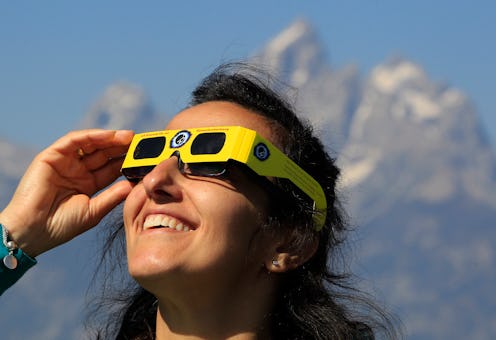Life
Yes, You Need Eclipse Glasses To Watch February’s Partial Solar Eclipse

Let's travel back in time to a different place: specifically Aug. 2017. News that a total solar eclipse would be soon passing directly through America had everyone buzzing. All people could talk about was when they would see the eclipse, and how. Eclipse glasses sold out in stores across the country, and people raced out of work and school in the middle of the day to stare up into the sky wearing their protective eye gear. There was complete chaos surrounding procurement of eclipse glasses, but it was a total solar eclipse — of course glasses were necessary to see it safely. However, with the approach of another eclipse — this time a partial one — people who are planning to check it out may be wondering if they need eclipse glasses for the Feb. 15 partial solar eclipse, since the eclipse won't reach totality.
Considering they happen multiple times a year, partial solar eclipses are far more common than total solar eclipses. This type of eclipse happens about once every 18 months or so at some location on Earth. And yet, it's still not common knowledge whether or not you need eclipse glasses for a partial solar eclipse.
Well, here's the short answer: Yes, you absolutely need them if you plan on looking at any eclipse, partial or total. The risk of eye damage is just as high.
Why You Need Eclipse Glasses
If you're unsure why looking at the sun is so dangerous, there's a few reasons. When the sun's rays hit Earth, the first thing to come through is the visible light. However, it is immediately followed by UVB rays. These rays have the potential to burn your corneas' outer cells leading to painful and blurry vision. Once the UVB rays are through, the even more dangerous UVA rays come. If your eyes directly absorb UVA rays, both your retina and your macula can become damaged, leading to macular degeneration or even potentially permanent blindness.
You also cannot use your sunglasses as an alternative to eclipse glasses. Eclipse glasses are made of black polymer, a material that is created when flexible resin is infused with carbon particles. Forbes reports that black polymer is 100,000 times darker than your average sunglasses. So, no, unfortunately your sunglasses won't even sort of work — they're too weak. When you look into eclipse glasses without the sun, you should see just darkness. That will give you an idea if. one, they are actually functioning properly, and two, of how much stronger they are than your sunglasses.
If you're having trouble finding eclipse glasses or are simply running out of time, it is possible to DIY them. Before the Aug. 2017 total solar eclipse, National Geographic released instructions on how to properly create your own eclipse glasses. To ensure they're safe, you will need quite a few supplies. Specifically you'll need duct tape, two pieces of stiff, white cardboard, aluminum foil, colored construction paper, a hole puncher, paper towel or wrapping paper tubes, pencils, push pins, scissors, and white card stock or construction paper. Simple, right? Honestly, you probably have all these things at home already anyways. Follow National Geographic's instructions to put it all together.
Have you used eclipse glasses, but still have a headache after viewing the partial solar eclipse? There's no need to worry as that's an extremely normal of staring at the sun's rays with or without glasses. The feeling should pass soon.
If you're going to be in the path of February's partial solar eclipse or any in the future, remember to buy eclipse glasses. Your eyes will thank you forever for it.